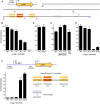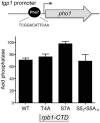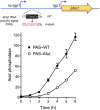Poly(A) site choice and Pol2 CTD Serine-5 status govern lncRNA control of phosphate-responsive tgp1 gene expression in fission yeast
- PMID: 29122971
- PMCID: PMC5769750
- DOI: 10.1261/rna.063966.117
Poly(A) site choice and Pol2 CTD Serine-5 status govern lncRNA control of phosphate-responsive tgp1 gene expression in fission yeast
Abstract
Expression of fission yeast glycerophosphate transporter Tgp1 is repressed in phosphate-rich medium and induced during phosphate starvation. Repression is enforced by transcription of the nc-tgp1 locus upstream of tgp1 to produce a long noncoding (lnc) RNA. Here we identify two essential elements of the nc-tgp1 promoter: a TATA box -30TATATATA-23 and a HomolD box -64CAGTCACA-57, mutations of which inactivate the nc-tgp1 promoter and de-repress the downstream tgp1 promoter under phosphate-replete conditions. The nc-tgp1 lncRNA poly(A) site maps to nucleotide +1636 of the transcription unit, which coincides with the binding site for Pho7 (1632TCGGACATTCAA1643), the transcription factor that drives tgp1 expression. Overlap between the lncRNA template and the tgp1 promoter points to transcriptional interference as the simplest basis for lncRNA repression. We identify a shorter RNA derived from the nc-tgp1 locus, polyadenylated at position +508, well upstream of the tgp1 promoter. Mutating the nc-tgp1-short RNA polyadenylation signal abolishes de-repression of the downstream tgp1 promoter elicited by Pol2 CTD Ser5Ala phospho-site mutation. Ser5 mutation favors utilization of the short RNA poly(A) site, thereby diminishing transcription of the lncRNA that interferes with the tgp1 promoter. Mutating the nc-tgp1-short RNA polyadenylation signal attenuates induction of the tgp1 promoter during phosphate starvation. Polyadenylation site choice governed by CTD Ser5 status adds a new level of lncRNA control of gene expression and reveals a new feature of the fission yeast CTD code.
Keywords: CTD code; phosphate homeostasis; polyadenylation.
© 2018 Sanchez et al.; Published by Cold Spring Harbor Laboratory Press for the RNA Society.
Figures






Similar articles
-
A long noncoding (lnc)RNA governs expression of the phosphate transporter Pho84 in fission yeast and has cascading effects on the flanking prt lncRNA and pho1 genes.J Biol Chem. 2018 Mar 23;293(12):4456-4467. doi: 10.1074/jbc.RA117.001352. Epub 2018 Feb 2. J Biol Chem. 2018. PMID: 29414789 Free PMC article.
-
Transcription of lncRNA prt, clustered prt RNA sites for Mmi1 binding, and RNA polymerase II CTD phospho-sites govern the repression of pho1 gene expression under phosphate-replete conditions in fission yeast.RNA. 2016 Jul;22(7):1011-25. doi: 10.1261/rna.056515.116. Epub 2016 May 10. RNA. 2016. PMID: 27165520 Free PMC article.
-
Transcriptional interference at tandem lncRNA and protein-coding genes: an emerging theme in regulation of cellular nutrient homeostasis.Nucleic Acids Res. 2020 Sep 4;48(15):8243-8254. doi: 10.1093/nar/gkaa630. Nucleic Acids Res. 2020. PMID: 32720681 Free PMC article. Review.
-
Suppression of inositol pyrophosphate toxicosis and hyper-repression of the fission yeast PHO regulon by loss-of-function mutations in chromatin remodelers Snf22 and Sol1.mBio. 2024 Jul 17;15(7):e0125224. doi: 10.1128/mbio.01252-24. Epub 2024 Jun 20. mBio. 2024. PMID: 38899862 Free PMC article.
-
Polyadenylation site selection: linking transcription and RNA processing via a conserved carboxy-terminal domain (CTD)-interacting protein.Curr Genet. 2017 May;63(2):195-199. doi: 10.1007/s00294-016-0645-8. Epub 2016 Aug 31. Curr Genet. 2017. PMID: 27582274 Review.
Cited by
-
An Overview on Identification and Regulatory Mechanisms of Long Non-coding RNAs in Fungi.Front Microbiol. 2021 Apr 28;12:638617. doi: 10.3389/fmicb.2021.638617. eCollection 2021. Front Microbiol. 2021. PMID: 33995298 Free PMC article. Review.
-
Genetic screen for suppression of transcriptional interference reveals fission yeast 14-3-3 protein Rad24 as an antagonist of precocious Pol2 transcription termination.Nucleic Acids Res. 2022 Jan 25;50(2):803-819. doi: 10.1093/nar/gkab1263. Nucleic Acids Res. 2022. PMID: 34967420 Free PMC article.
-
Genetic interactions and transcriptomics implicate fission yeast CTD prolyl isomerase Pin1 as an agent of RNA 3' processing and transcription termination that functions via its effects on CTD phosphatase Ssu72.Nucleic Acids Res. 2020 May 21;48(9):4811-4826. doi: 10.1093/nar/gkaa212. Nucleic Acids Res. 2020. PMID: 32282918 Free PMC article.
-
Structure-function analysis of fission yeast cleavage and polyadenylation factor (CPF) subunit Ppn1 and its interactions with Dis2 and Swd22.PLoS Genet. 2021 Mar 12;17(3):e1009452. doi: 10.1371/journal.pgen.1009452. eCollection 2021 Mar. PLoS Genet. 2021. PMID: 33711009 Free PMC article.
-
Inactivation of fission yeast Erh1 de-represses pho1 expression: evidence that Erh1 is a negative regulator of prt lncRNA termination.RNA. 2020 Oct;26(10):1334-1344. doi: 10.1261/rna.076463.120. Epub 2020 Jun 16. RNA. 2020. PMID: 32546512 Free PMC article.
References
-
- Chatterjee D, Sanchez AM, Goldgur Y, Shuman S, Schwer B. 2016. Transcription of lncRNA prt, clustered prt RNA sites for Mmi1 binding, and RNA polymerase II CTD phospho-sites govern the repression of pho1 gene expression under phosphate-replete conditions in fission yeast. RNA 22: 1011–1025. - PMC - PubMed
Publication types
MeSH terms
Substances
Grants and funding
LinkOut - more resources
Full Text Sources
Other Literature Sources
Molecular Biology Databases
